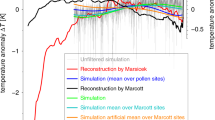Abstract
This chapter provides a general overview of climatic patterns and trends during the Holocene. Global climate during the Holocene responded to orbital, solar, and volcanic forcings, as well as internal variability. Global climate shifts influenced atmospheric circulation patterns, such as the migration of the Intertropical Convergence Zone (ITCZ), which in turn influenced local weather patterns. From a climate perspective, the Holocene can be roughly divided into three periods: an early period of maximum Northern Hemisphere summer insolation; a middle period of weakening summer monsoons in the Northern Hemisphere; and a late period marked by periodic cooling, strengthening El Niños, and more restricted seasonal migration of the ITCZ.
Similar content being viewed by others
Notes
- 1.
- 2.
- 3.
- 4.
Esper et al., 2012.
Bibliography
Anderson, David G. “Climate and Culture Change in Prehistoric and Early Historic Eastern North America.” Archaeology of Eastern North America 29 (2001): 143–86.
Berger, A., and M.F. Loutre. “Insolation Values for the Climate of the Last 10 Million Years.” Quaternary Science Reviews 10 (1991): 297–317.
Bradley, Raymond S. Paleoclimatology: Reconstructing Climates of the Quaternary. Third edition. Amsterdam: Elsevier, 2015.
Brooke, John L. Climate Change and the Course of Global History: A Rough Journey. New York: Cambridge University Press, 2014.
Cronin, Thomas M. Paleoclimates: Understanding Climate Change Past and Present. New York: Columbia University Press, 2010.
deMenocal, P. et al. “Abrupt Onset and Termination of the African Humid Period: Rapid Climate Responses to Gradual Insolation Forcing.” Quaternary Science Reviews 19 (2000): 347–61.
Dykoski, Carolyn A. et al. “A High-Resolution, Absolute-Dated Holocene and Deglacial Asian Monsoon Record from Dongge Cave, China.” Earth and Planetary Science Letters 233 (2005): 71–86.
Esper, Jan et al. “Orbital Forcing of Tree-Ring Data.” Nature Climate Change 2 (2012): 862–66.
Fowler, Brenda. Iceman: Uncovering the Life and Times of a Prehistoric Man Found in an Alpine Glacier. New York: Random House, 2000.
Grootes, P.M., and M. Stuiver. “Oxygen 18/16 Variability in Greenland Snow and Ice with 10^3 to 10^5-Year Time Resolution.” Journal of Geophysical Research 102 (1997): 26.
Haug, Gerald H. et al. “Southward Migration of the Intertropical Convergence Zone Through the Holocene.” Science 293 (2001): 1304–08.
Marcott, Shaun A. et al. “A Reconstruction of Regional and Global Temperature for the Past 11,300 Years.” Science 339 (2013): 1198–201.
Mayewski, Paul A. et al. “Holocene Climate Variability.” Quaternary Research 62 (2004): 243–55.
Moy, C.M. et al. “Variability of El Niño/Southern Oscillation Activity at Millennial Timescales during the Holocene Epoch.” Nature 420 (2002): 162–65.
Nussbaumer, Samuel U. et al. “Alpine Climate during the Holocene: A Comparison between Records of Glaciers, Lake Sediments and Solar Activity.” Journal of Quaternary Science 26 (2011): 703–13.
Roberts, Neill. The Holocene: An Environmental History. Third edition. New York: Wiley Blackwell, 2014.
Roberts, N. et al. “The Mid-Holocene Climatic Transition in the Mediterranean: Causes and Consequences.” The Holocene 21 (2011): 3–13.
Rohling, E. et al. “Holocene Atmosphere-Ocean Interactions: Records from Greenland and the Aegean Sea.” Climate Dynamics 18 (2002): 587–93.
Shapiro, A.I. et al. “A New Approach to the Long-Term Reconstruction of the Solar Irradiance Leads to Large Historical Solar Forcing.” Astronomy and Astrophysics 529 (2011): A67.
Wanner, H. et al. “Holocene Climate Variability and Change: A Data-Based Review.” Journal of the Geological Society 172 (2015): 254–63.
Author information
Authors and Affiliations
Editor information
Editors and Affiliations
Copyright information
© 2018 The Author(s)
About this chapter
Cite this chapter
Brooke, J.L. (2018). The Holocene. In: White, S., Pfister, C., Mauelshagen, F. (eds) The Palgrave Handbook of Climate History. Palgrave Macmillan, London. https://doi.org/10.1057/978-1-137-43020-5_15
Download citation
DOI: https://doi.org/10.1057/978-1-137-43020-5_15
Published:
Publisher Name: Palgrave Macmillan, London
Print ISBN: 978-1-137-43019-9
Online ISBN: 978-1-137-43020-5
eBook Packages: HistoryHistory (R0)




